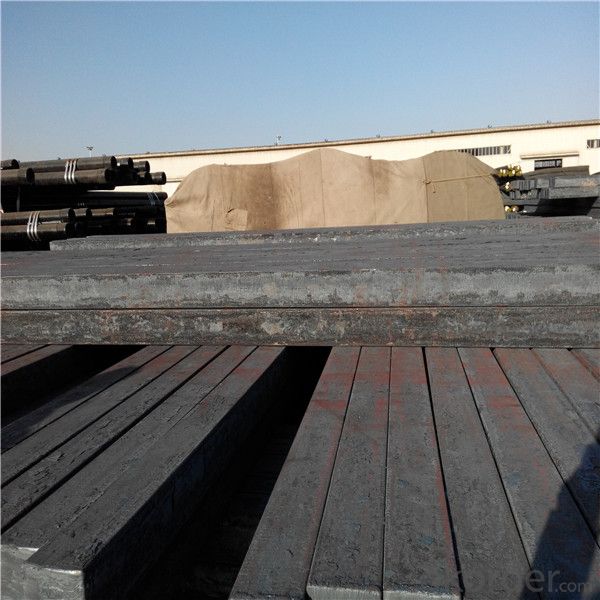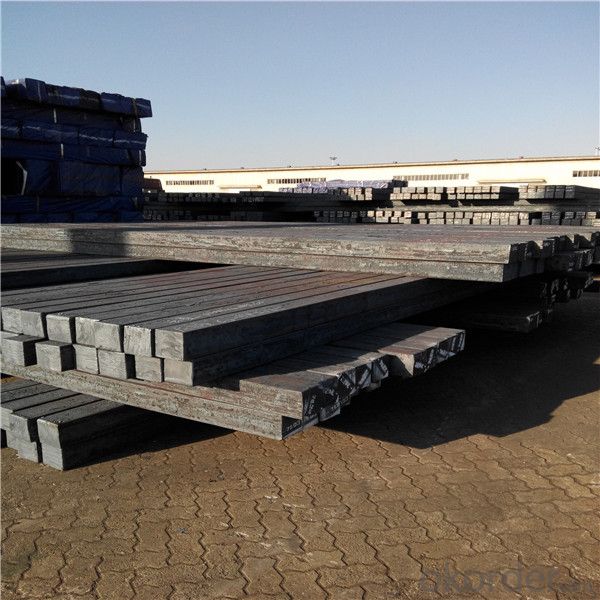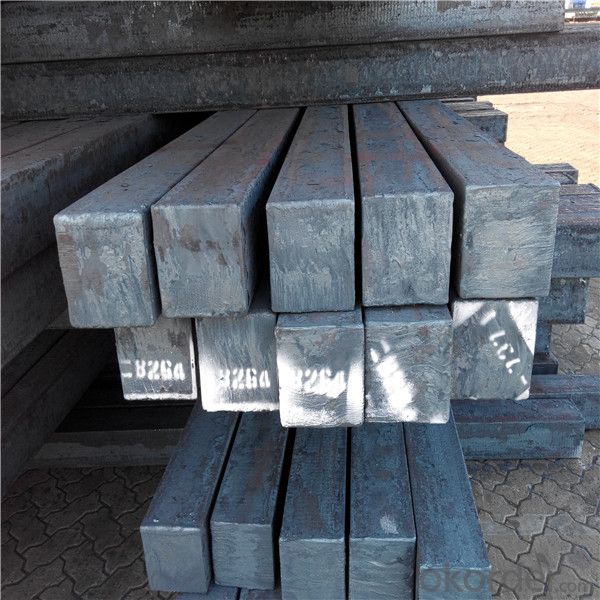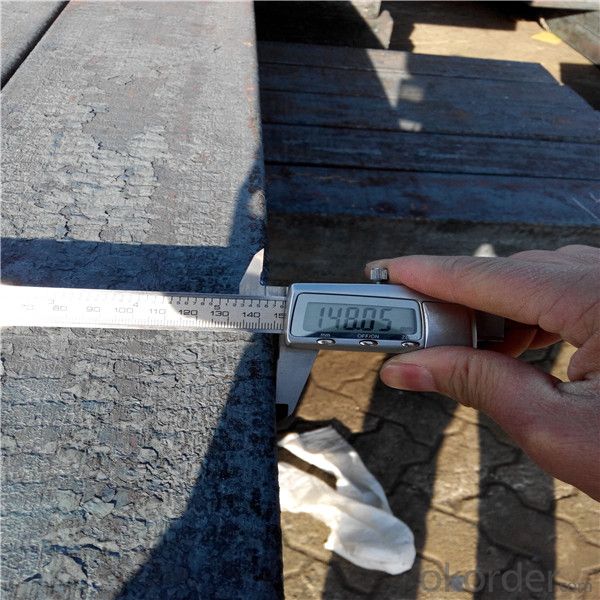Square Billets for steel products material
- Loading Port:
- China main port
- Payment Terms:
- TT OR LC
- Min Order Qty:
- 10000 m.t.
- Supply Capability:
- 14980 m.t./month
OKorder Service Pledge
OKorder Financial Service
You Might Also Like
Item specifice
Steel billet
(ingot) by cogging or breakdown of semifinished products, is the raw material of all kinds of steel mill.
Billet section of square, round, flat, rectangular and abnormity of several kinds of, mainly related to the
shape of rolled products.
Rectangular billet continuous casting billet and mainly general carbon steel, low carbon low silicon cold-rolled material, high quality carbon structural steel, high strength low alloy steel, special steel, etc.
The billet is mainly divided into two kinds from the shape:
Slab: cross section width and height of the ratio of the larger, mainly used for rolling plate.
Gade:
Standard | C(%) | Mn(%) | S(%) | P(%) | Si(%) |
Q195 | ≤0.12 | ≤0.50 | ≤0.040 | ≤0.035 | ≤0.30 |
Q235 | ≤0.20 | ≤1.40 | ≤0.045 | ≤0.045 | ≤0.35 |
Q275 | ≤0.22 | ≤1.50 | ≤0.045 | ≤0.045 | ≤0.35 |
20MnSi | 0.17-0.25 | 1.2-1.6 | ≤ 0.050 | ≤ 0.050 | 0.40-0.80 |
3SP | 0.14-0.22 | 0.40-0.85 | ≤ 0.050 | ≤ 0.040 | 0.05-0.15 |
5SP | 0.28-0.37 | 0.50-1.00 | ≤ 0.050 | ≤ 0.040 | 0.15-0.30 |




Our service :
We have a plant and professional team to provide our best service, from the start of production until the
loading into the vessel, we have a complete quality follow up procedure, to assure our products arrives to the customer with satisfaction. Welcome new and old customers
to contact us for future business relationships! We will give you a surpise price.
Packing :
Within 30 days
1.Standard export package
2.In bundles with steel strips
3.As the requirements of the customers
FAQ:
Q: What is payment terms?
A: FOB 30% T/T IN ADVANCE AS DEPOSIT AND 70% T/T BEFORE SHIPMENT
CIF and CFR 30% T/T IN ADVANCE AS DEPOSIT AND 70% T/T AS THE COPY OF B/L OR L/C AT SIGHT
Q:How to guarantee the quality of the products?
A:We have established the international advanced quality management system,every link from raw material
to final product we have strict quality test;We resolutely put an end to unqualified products flowing into the market.
At the same time, we will provide necessary follow-up service assurance.
Q:How long can we receive the product after purchase?
A :In the purchase of product within three working days, We will arrange the factory delivery as soon as possible.
The pecific time of receiving is related to the state and position of customers.
- Q:How does the quality of steel billets affect the quality of the final product?
- The quality of steel billets significantly impacts the quality of the final product. The composition, purity, and uniformity of the steel billets directly influence the structural integrity, strength, and performance of the finished steel product. Imperfections or impurities in the billets can lead to defects, such as cracks or weak spots, in the final product. Therefore, ensuring high-quality steel billets is crucial in producing a superior final steel product.
- Q:What are the common grades of steel used for billets?
- The grades of steel commonly used for billets can vary depending on the intended application and specific requirements. However, there are several widely used grades: 1. Carbon Steel: Carbon steel billets are popular due to their affordability, high strength, and durability. Grades like AISI 1018, 1020, 1045, and 1060 are commonly chosen for general-purpose uses. 2. Alloy Steel: Alloy steel billets are blended with specific alloying elements to enhance their mechanical properties, such as strength, toughness, and corrosion resistance. AISI 4140, 4340, and 8620 are frequently utilized for applications that require increased strength, heat resistance, or wear resistance. 3. Stainless Steel: Stainless steel billets are selected for their excellent corrosion resistance and attractive appearance. Grades such as 304, 316, and 420 are commonly employed in various industries, including construction, automotive, and food processing. 4. Tool Steel: Tool steel billets are specially designed to possess high hardness, wear resistance, and toughness. Grades like AISI O1, D2, and A2 are commonly used in the production of cutting tools, dies, and molds. It is important to note that choosing the appropriate grade of steel depends on specific application requirements, such as mechanical properties, corrosion resistance, and temperature resistance. Seeking advice from a metallurgist or an industry expert can assist in determining the most suitable grade of steel for billet production.
- Q:What are the different types of straightening methods used for steel billets?
- There are several different types of straightening methods used for steel billets, depending on the specific requirements and desired outcome. These methods include: 1. Roller Straightening: This method involves passing the steel billets through a series of rollers that apply pressure in various directions to straighten them. The rollers can be adjusted to apply more pressure on certain areas of the billet that may be bent or twisted. 2. Hydraulic Straightening: In this method, hydraulic presses are used to apply pressure on the billets, either in a single direction or in multiple directions. The pressure can be adjusted to achieve the desired level of straightness. 3. Heat Straightening: Heat straightening is a method that involves applying heat to the bent or twisted areas of the steel billets and then using hydraulic or mechanical tools to straighten them. The heat softens the steel, allowing it to be reshaped more easily. 4. Hammering: Hammering is a traditional method of straightening steel billets, where skilled workers use hammers and anvils to manually reshape the billets. This method requires a high level of skill and precision to achieve the desired straightness. 5. Magnetic Straightening: Magnetic straightening is a non-contact method that uses magnetic fields to apply forces on the steel billets and straighten them. This method is often used for smaller and thinner billets, where other methods may cause damage or distortion. Each of these straightening methods has its own advantages and limitations, and the choice of method depends on factors such as the size and thickness of the billets, the degree of straightness required, and the available equipment and resources.
- Q:What are the different types of steel used for manufacturing billets?
- There are several different types of steel that are commonly used for manufacturing billets, including carbon steel, alloy steel, stainless steel, and tool steel. These different types of steel have varying levels of strength, hardness, and corrosion resistance, allowing manufacturers to select the most suitable steel for the specific application and requirements of the billets.
- Q:How is the quality of steel billets ensured during production?
- The quality of steel billets is ensured through various measures implemented during the production process. Here are some key factors that contribute to ensuring the quality of steel billets: 1. Raw Material Selection: The quality of steel billets starts with the selection of high-quality raw materials, such as iron ore, coal, and scrap metal. These materials undergo rigorous testing to ensure they meet the required specifications and standards. 2. Melting and Refining: Steel billets are produced through the process of melting and refining the raw materials. During this stage, advanced technologies and equipment are used to control the temperature and chemical composition, ensuring uniformity and consistency in the final product. 3. Continuous Casting: The molten steel is then poured into a continuous casting machine, where it solidifies into billet form. Continuous casting allows for precise control over the cooling process, resulting in billets with uniform dimensions and internal structure. 4. In-line Inspection: Modern production facilities incorporate in-line inspection systems that continuously monitor and analyze the quality of the steel billets during the production process. These systems use various techniques such as laser measurement, ultrasonic testing, and magnetic particle inspection to detect any defects or abnormalities. 5. Heat Treatment: After the initial production, steel billets may undergo heat treatment processes such as annealing or quenching to enhance their mechanical properties and eliminate any residual stresses. These treatments are carefully controlled to achieve the desired results and improve the overall quality of the billets. 6. Testing and Quality Control: Steel billets undergo comprehensive testing to ensure they meet the required standards and specifications. This includes various mechanical and chemical tests, such as tensile strength, hardness, and chemical composition analysis. Additionally, non-destructive testing methods like ultrasonic testing and X-ray inspection are employed to detect any internal defects or flaws. 7. Traceability and Documentation: Throughout the production process, comprehensive documentation is maintained to track each batch of steel billets, from the raw materials used to the final testing results. This ensures traceability and provides a record for quality control purposes. By implementing these measures and following strict quality control procedures, steel manufacturers can ensure that the steel billets produced meet the required quality standards and are suitable for further processing and use in various industries.
- Q:Can steel billets be used for making jewelry?
- Although steel billets have the technical capability to be utilized in the creation of jewelry, it is not a material commonly chosen or favored for this particular purpose. Steel's main applications lie within the construction and manufacturing sectors, given its notable strength and durability. Conversely, jewelry often necessitates materials that possess visually appealing attributes, malleability, and hypoallergenic properties. When it comes to fine jewelry, steel is not typically regarded as visually attractive due to its lack of luster and shine, which are inherent in precious metals like gold or silver. In addition, steel lacks the malleability of other metals commonly employed in jewelry production, thereby making it arduous to fashion intricate designs or delicate details. Lastly, steel may not be hypoallergenic, potentially causing allergic reactions or skin irritations for certain individuals wearing steel jewelry. In summary, while steel billets can technically be employed in jewelry making, they are not the most fitting or favored material for this purpose.
- Q:What are the different types of machining processes used for shaping steel billets?
- There are several different types of machining processes that can be used to shape steel billets. Here are some of the most common ones: 1. Turning: This process involves rotating the billet against a cutting tool, which removes material from the outer surface. It is often used to create cylindrical shapes or to remove excess material from the billet. 2. Milling: In milling, a rotating cutting tool is used to remove material from the surface of the billet. This process can be used to create flat surfaces, slots, or complex shapes. 3. Drilling: Drilling is the process of creating holes in the billet using a rotating cutting tool. It can be done manually or with the help of a drilling machine. 4. Grinding: Grinding is a process that uses an abrasive wheel or belt to remove material from the surface of the billet. It is often used to achieve a smooth and precise finish. 5. Broaching: Broaching involves using a broach, which is a toothed cutting tool, to remove material from the billet. This process is often used to create internal or external splines, keyways, or other special shapes. 6. Sawing: Sawing is a cutting process that uses a saw blade to separate the billet into smaller pieces or to remove excess material. It can be done manually or with the help of a sawing machine. These are just a few examples of the machining processes used for shaping steel billets. Each process has its own advantages and is chosen based on the specific requirements of the final product.
- Q:How are steel billets made?
- The process of making steel billets is known as casting. It begins by melting raw materials like iron ore, coal, and limestone in a blast furnace until they become molten iron. This molten iron is then further purified in either a basic oxygen furnace or an electric arc furnace to adjust its composition and remove impurities. Once the desired composition is achieved, the molten iron is poured into a continuous casting machine. This machine contains a copper mold that is cooled by water, which shapes the molten iron into a solid billet. As the molten iron is poured into the mold, it cools rapidly and solidifies, creating a continuous length of solid steel. The billet is then cut to the desired length and moved to a storage area to cool down even more before undergoing further processing. The cooling process is vital as it helps improve the internal structure and overall quality of the billet. After cooling, the steel billets can undergo various treatments, such as heat treatment or surface conditioning, to enhance their mechanical properties and surface finish. They can also be processed further into different shapes and sizes through methods like rolling, forging, or extrusion to meet specific requirements of customers. In summary, the production of steel billets involves melting the raw materials, purifying the molten iron, casting it into a continuous mold, and subsequently cooling and processing the solid billets. This process guarantees the production of high-quality steel billets that are essential components for industries such as construction, automotive, and manufacturing.
- Q:How are steel billets used in the production of construction equipment?
- Construction equipment production relies heavily on the use of steel billets. These semi-finished steel forms are essential in creating different components for construction equipment. The process of continuous casting is typically used to manufacture these billets, where molten steel is solidified in molds to form solid rectangular or square shapes. After obtaining steel billets, further processing is carried out to transform them into the desired construction equipment parts. This involves shaping, cutting, and machining the billets to create components like gears, shafts, axles, and structural frames. The versatility of steel allows these components to be customized to meet the specific requirements of different construction equipment. The utilization of steel billets in construction equipment production offers numerous advantages. Firstly, steel is known for its exceptional strength and durability, making it a perfect choice for heavy-duty applications. By incorporating steel billets, construction equipment manufacturers can ensure that their products can withstand the demanding conditions of construction sites and provide long-lasting performance. Additionally, steel billets can be easily welded, enabling the assembly of complex structures and components. This welding capability is crucial in construction equipment production, where multiple parts need to be securely joined together to create a robust and reliable machine. Furthermore, steel billets possess excellent machinability, allowing them to be easily shaped and formed into desired dimensions. This facilitates the precise manufacturing of intricate components, enhancing the overall performance and functionality of the construction equipment. Lastly, steel billets are readily available in a wide range of grades and compositions. This enables manufacturers to select the most suitable steel alloy for their specific construction equipment applications. This flexibility allows for the optimization of the equipment's performance, weight, and cost-effectiveness. In conclusion, steel billets play a crucial role in construction equipment production as they serve as the raw material for various components. Their strength, durability, weldability, machinability, and range of available alloys make them an ideal choice for manufacturing construction equipment that can withstand the demanding conditions of construction sites and deliver long-lasting performance.
- Q:How are steel billets cooled after the manufacturing process?
- Steel billets are typically cooled after the manufacturing process through a process known as water quenching. Water quenching involves rapidly cooling the steel billets by immersing them in a water bath or spraying a high-pressure water stream onto the billets. This rapid cooling process helps to control the microstructure of the steel, resulting in desirable properties such as increased strength and hardness. Water quenching is often preferred for steel billets because it allows for efficient and uniform cooling, ensuring consistent quality throughout the billets. Additionally, water quenching is a cost-effective method compared to other cooling methods. However, it is important to note that the cooling process may vary depending on the specific requirements of the steel being manufactured, and alternative cooling methods such as air cooling or oil quenching may also be utilized.
1. Manufacturer Overview |
|
|---|---|
| Location | |
| Year Established | |
| Annual Output Value | |
| Main Markets | |
| Company Certifications | |
2. Manufacturer Certificates |
|
|---|---|
| a) Certification Name | |
| Range | |
| Reference | |
| Validity Period | |
3. Manufacturer Capability |
|
|---|---|
| a)Trade Capacity | |
| Nearest Port | |
| Export Percentage | |
| No.of Employees in Trade Department | |
| Language Spoken: | |
| b)Factory Information | |
| Factory Size: | |
| No. of Production Lines | |
| Contract Manufacturing | |
| Product Price Range | |
Send your message to us
Square Billets for steel products material
- Loading Port:
- China main port
- Payment Terms:
- TT OR LC
- Min Order Qty:
- 10000 m.t.
- Supply Capability:
- 14980 m.t./month
OKorder Service Pledge
OKorder Financial Service
Similar products
New products
Hot products
Hot Searches
Related keywords





























